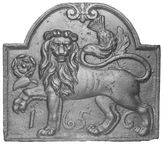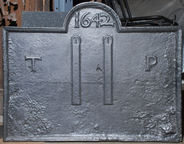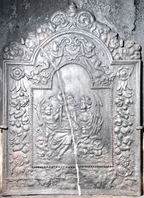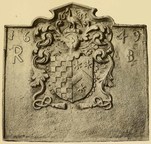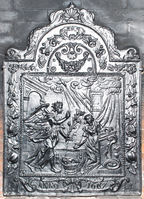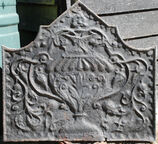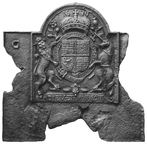-
399
Description: Arched rectangular shape; ovolo-moulded edging with inverted fleur-de-lys at top; lion passant guardant, with rose to the left and thistle above tail; date split between legs; single horizontal plank-line.
Notes: The boldness of the figuration suggests association with firebacks possibly cast at Brede Furnace in the same period.
Copies of this fireback are known.
Inscription: 1 6 5 6
- Decoration tags:
- rectangular with round arch (shape)
- cyma reversa/ogee (edging)
- whole carved pattern
- planklines
- heraldic
- text
- animals
- plants
Manufactured: in 1656 in the Weald area of England.
Current location: not known.
- Attached to series:
- Royalist series
-
220
Description: Rectangular with cavetto moulded edging; English Royal supporters (crowned lion and unicorn) standing upon a cartouche, upon which rests a blank motto scroll; above, an anchor, surrounded by a looped cable is encircled by the Garter ribbon, which is surmounted by a royal coronet; the numbers ‘61’, presumably part of the date, are to the right of the unicorn, and a letter, ‘D’, is placed between the unicorn and the coronet.
Notes: From another casting of the same back, the date is known to be 1661. The cabled anchor is the badge of the Lord High Admiral who, in 1661, was the Duke of York and Albany, later James II. The missing initial is an ‘I’, for Jacobus Dux. The absence of the motto may be explained by the pattern being a carved armorial panel where the motto text, unlike that of the Garter, was merely painted.
Copies of this fireback are known.
Inscription: [I] D / 16 61
Arms: Lord High Admiral of England
- Decoration tags:
- rectangular (shape)
- cavetto (edging)
- whole carved pattern
- individual letters
- individual numbers
- armorial
- text
Manufactured: in 1661 possibly in the Weald area of England.
Current location: Preston Manor, Brighton, East Sussex, England.
Museum number: PM400269 (part of the Brighton Museum museum group)
- Attached to series:
- Miscellaneous royal firebacks
-
217
Description: Arched rectangular shape; ovolo edging; date in arch; below arch, two parallel straps, each with a buckle at the top; initials left and right of centre; rectangular stamp with bird, four times across top.
Notes: The buckles, the date and the initials all appear to be separate stamps but attached to the base board before being impressed to form the mould, as they are identically positioned on all castings. The buckles suggest a connection with the Pelham family; the initials may relate to Sir Thomas Pelham, Bt. (1597-1654) who owned and operated ironworks at Waldron and Crowhurst in Sussex. This would appear to be a casting of the original pattern.
Copies of this fireback are known.
Inscription: 1642 / T P
- Decoration tags:
- rectangular with round arch (shape)
- ovolo (edging)
- whole carved pattern
- individual numbers
- planklines
- text
- objects
Manufactured: in 1642 probably at Waldron Furnace in the Weald area of England.
Current location: Brighton Museum and Art Gallery, Brighton, East Sussex, England.
Museum number: HA105912 (part of the Brighton Museum museum group)
Citation: Lindsay, J. S., 1927, Iron & Brass Implements of the English House (London, The Medici Society).
- Attached to series:
- 1642 Pelham series
- Pelham family firebacks
-
971
Description: Canted rectangle; fillet edging (top and sides); top centre, date between two 'rose' stamps.
Notes: The four nuts are to secure the fireback to two legs.
Inscription: 1658
- Decoration tags:
- rectangular with canted top corners (shape)
- fillet (edging)
- carved stamps
- individual numbers
- text
- plants
Manufactured: in 1658 in England.
Current location: Red Lodge, Park Row, Bristol, England.
Museum number: NX412 (part of the Bristol Museums, Galleries and Archives museum group)
- Attached to series:
- Date only firebacks
-
1002
Description: Arched rectangular shaped central panel with bead edging; pictorial scene of a seated female figure resting against a hurdle, holding an anchor, a child on each side of her, the one on the left standing clutching corn stalks, the one on the right sitting also holding the anchor and a circular object; a bird sits on a post; arched rectangular border with bead edging; fructal and floral festoons suspended on ribbons with two putti at the top and two on each side; in the left and right bottom corners, the initials 'HH' and 'S' respectively; at the bottom, a central cartouche with date, between floral swags; on top, twin spirals between descending floral festoons.
Notes: The figure is an allegory of Hope. The theft in 1699 from a Thames-side warehouse of several firebacks, including '3 of Hope with an Anchor' may refer to this type (Post Boy 11-14 Nov. 1699). A recasting.
Copies of this fireback are known.
Inscription: [?H]H ...
- Decoration tags:
- 'Dutch' (shape)
- ovolo (edging)
- whole carved pattern
- pictorial
- allegorical
- text
- animals
- humans
- objects
Manufactured: in the mid-17th century in the Siegerland area of Germany.
Current location: Ashmolean Museum Broadway, 65 High Street, Broadway, Worcestershire, England.
(part of the Ashmolean Museum museum group)
- Attached to series:
- 'Dutch' HHS series
- Hope firebacks
-
831
Description: Rectangular with small detached pediment; cavetto-moulded edging; upper centre, shield, helm, crest and mantling, with date, 1635, split either side of crest; top, date, 1649, split either side of armorial; initials split either side of armorial, below date.
Notes: The armorial, tentatively associated with the family of Brooke or Broke of Madeley, Shropshire (blazon: chequy argent and sable, impaling a chevron between three estoiles), dated 1635, was formed from a pattern designed for a smaller fireback (see no. 917), but positioned on a larger backing board with the later date and initials added separately, most of the frame of the original fireback being pared away. From an illustration in the catalogue of an exhibition on heraldry at Burlington House, London, in 1894.
Inscription: 16 35 / 16 49 / R B
Arms: poss. Brooke or Broke of Staffordshire
- Decoration tags:
- rectangular with detached pediment (shape)
- cavetto (edging)
- carved stamps
- carved pattern panels
- composite
- individual letters
- individual numbers
- armorial
- text
Manufactured: in 1649 in England.
Current location: not known.
- Attached to series:
- Personal armorial firebacks
- Composite firebacks
-
21
Description: Rectangular central panel with bead edging all round, pictorial representation of the Annunciation by the Angel Gabriel to the Virgin Mary, the angel carries a lily, Mary kneels at a desk, between them is a basket, above them a dove descends from clouds amid sunbeams, to the left is an arch, in the centre a bed, and to the right a window and a canopy; above the panel is a bead-edged arch with a central scallop shell and a floral swag suspended from scrolls; arched rectangular shaped border with fillet edging, a cascade of leaves and fruit (inc. apples, grapes, pears and pomegranates) descending from a wreath, at the base two cartouches conjoined by a scallop shell and containing the inscription; on top a scallop shell between two dolphins.
Notes: A common fireback design originating in the Siegerland of north Germany and made for the Dutch market. A good clear casting. The illustration is copied from Virgil Solis, 'Biblische Figuren',1562.
Copies of this fireback are known.
Inscription: ANNO 1667
Manufactured: in 1667 in the Siegerland area of Germany.
Current location: Bateman's, Burwash, East Sussex, England.
Museum number: 761056 (part of the National Trust museum group)
Citation: Herskamp, W, 2007, Die Eiserne Bibel (Helios, Aachen).
- Attached to series:
- 'Dutch' Miscellaneous Firebacks
- New Testament firebacks
-
1308
Description: Rectangular with cavetto curves rising to corners and a ‘pediment’ top; fillet edging with low-relief, alternate regularly-spaced semi-circles and triangles inside; two-handled flower vase with gadrooned top and symmetrical flower design; trailing vines and flowers issuing from top and descending through handles to base; human face at top; date split by vase base.
Notes: The style of the numerals includes a ‘1’ with hooked serifs.
Inscription: 16 52
- Decoration tags:
- rectangular with canted top corners and triangular arch (shape)
- scalloped fillet (edging)
- whole carved pattern
- pictorial
- text
- plants
- objects
Manufactured: in 1652 in the Weald area of England.
Current location: in private hands, Buxted, East Sussex, England.
- Attached to series:
- Gadrooned vase firebacks
- Hooked '1' series
- Brede group
-
224
Description: Composite; Arched rectangular shaped, armorial fireback, cavetto edging, with Stuart Royal arms, garter, supporters, crown and motto, and 1639 date above crown; this overlies a rectangular plate, with rope-effect, fillet edging; a pattern of four rosettes surrounding a fleur-de-lys, its stem terminating in a small buckle, is repeated on each side of the central armorial fireback, with the initials above; each rosette is stamped separately.
Notes: The armorial may originally have been one of the 1619 series. Formerly at Wonastow Court, Momouthshire
Inscription: 1639 / G / HONI SOIT QVI MAL Y PENSE / DIEV ET MO DROIT
Arms: English Stuart royal
- Decoration tags:
- rectangular with round arch (shape)
- fillet (edging)
- whole carved pattern
- composite
- individual letters
- armorial
- text
Manufactured: in 1639 possibly in the Forest of Dean area of England.
Current location: National History Museum, St Fagans, Glamorgan, Wales.
Museum number: 40.428 (part of the Welsh National History Museum museum group)
-
1070
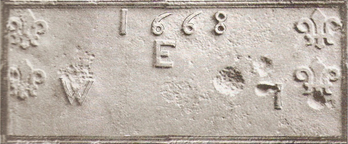 ? x ? mm
? x ? mmDescription: Rectangular; ovolo-moulded edging; two fleurs-de-lys arranged vertically top left and top right; top centre, date; below date, initials WEI in triad.
Notes: Said to have been made by George White, iron founder, of Monmouth. Formerly from Newport, Monmouthshire.
Inscription: 1668 / W E I [triad]
- Decoration tags:
- rectangular (shape)
- ovolo (edging)
- carved stamps
- individual letters
- individual numbers
- heraldic
- text
Manufactured: in 1668 possibly at Tintern Furnace in the Forest of Dean area of Wales.
Current location: National History Museum, St Fagans, Glamorgan, Wales.
Museum number: 25.21 (part of the Welsh National History Museum museum group)
Citation: Kissack, K., 2003, Monmouth and its Buildings (Almeley, Logaston Press).
- Attached to series:
- Date & initials firebacks
